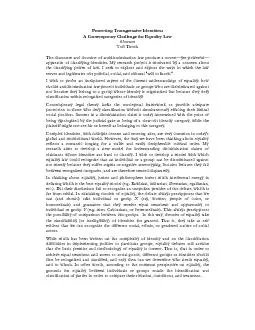

My examples are loosely based on the facts and law of two US cases Rosa v Park West Bank Trust 214 F3d 213 1st Cir 2000 and on Jespersen v Harrahs Operating Company Inc 392 F3d 1076 2004 ID: 846672
Download Pdf The PPT/PDF document "But what of those who are hard to classi..." is the property of its rightful owner. Permission is granted to download and print the materials on this web site for personal, non-commercial use only, and to display it on your personal computer provided you do not modify the materials and that you retain all copyright notices contained in the materials. By downloading content from our website, you accept the terms of this agreement.
1 But what of those who are hard to classi
But what of those who are hard to classify under particular category of identity? How can we recognize claims of groups or individuals that are discriminated against precisely because they challenge the clear boundaries between identities? Normally, the response of courts to claims of plaintiffs of this kind is either to deny such claims, for the plaintiffs are not able to position themselves solidly as members of a particular group, or to reclassify the legal subject in one of the preexisting identity categories available to it, so that even if the legal subject entered the courtroom without a clear label, he or she leaves the court with a designated place in the social structure. This judicial act of clear repositioning of the plaintiff's identity allows the law to compare the plaintiff's position to those in the opposite category and determine whether he or she received equal treatment. Consider, for example, the case of a man who comes to work wearing women's clothes and is dismissed for refusing to wear attire that matches his gender. For many years, such a plaintiff's sex-based discrimination claim would have been denied by the courts. The prevailing antidiscrimination doctrine had been short of conceptual tools to handle such a claim, because the courts would be puzzled as to how to apply equality doctrine. Specifically, it would be unclear whether the plaintiff was arguing that he was discriminated as a man or as a woman. Thus it would be unclear to what group his treatment should be compared. Today, such a plaintiff might be able to win his case, but only if he proves that the employer who treated him adversely took him to be a man, and not a homosexual or transgender man (the former category is protected under federal US antidiscrimination law, as opposed to homosexuality or transsexuality, which is not). We see, therefore, that if the legal subject's identity is socially perceived as blurred or located on
2 the border between two categories, the
the border between two categories, the law currently lacks the ability to relate to it effectively. Now compare this case to the case of a female employee who refuses to wear makeup at work, because she feels that the 'feminine' appearance required of her impaired her ability to be assertive with customers claim for sex based discrimination would be rejected under the prevailing logic of equality law, since she cannot show that similarly situated men have been treated differently (after all, just as women are required to wear makeup, men are required to refrain from wearing makeup). Moreover, while both plaintiffs blur the dividing line between femininity and masculinity, the difference that leads to the inconsistent legal outcomes in that the latter did not have a category of identity in which to anchor her 'bare face' (she did not claim that she was transgender or lesbian), while the former did have such a category. Viewed from a different angle, my research will aim to highlight the ways in which equality discourse serves, albeit unwittingly, to reify and sustain prevailing typologies of identity. This project emanates from an awareness that despite the good intentions of its framers, the concept of equality as currently understood and applied presents constraints to contemporary individuals' complex axis of identity and affiliation, and limits their freedom and ability to choose and pursue a life path that is "less traveled by" and be part of the social structure in ways that contribute to its ongoing change and development. It is time to recognize the ways in which those whose identity is not easily classifiable suffer from discrimination, and develop the theoretical tools and the practical means to mitigate My examples are loosely based on the facts and law of two US cases: Rosa v. Park West Bank & Trust, 214 F.3d 213 (1st Cir. 2000), and on Jespersen v. Harrah's Operating Company Inc 392 F.3d 1076 (2004)